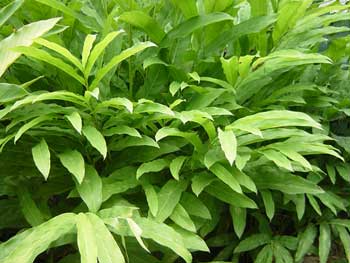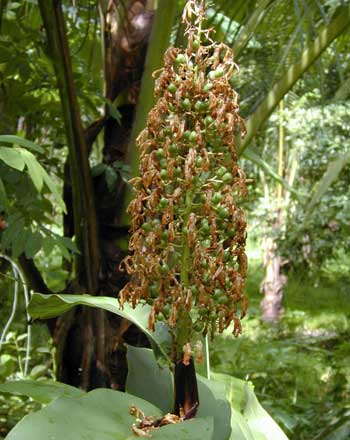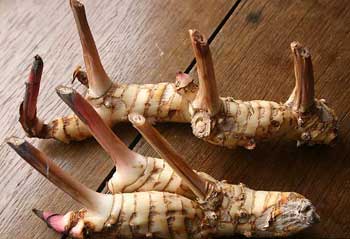Contents:
Common Names | Parts Usually Used | Plant(s) & Culture | Where Found | Medicinal Properties | Biochemical Information
Legends, Myths and Stories | Uses | Formulas or Dosages | Bibliography
Scientific Names

- Alpinia galanga L.
- Alpinia officinarum L.
- Zingiberaceae
- Ginger family
Common Names
- Catarrh root
- Galanga
- Galingal, greater or lesser
- Large galangal
Parts Usually Used
Rootstock
Back to Top

Description of Plant(s) and Culture
Galangal is a perennial plant; the creeping rootstock is cylindrical and branched, ringed with the leaf sheaths of the past, rust brown or red outside, and gray-white and mealy inside. Its odor and taste are reminiscent of its relative, ginger. Aside from the basal leaves, procumbent stems also bear linear-lanceolate leaves as well as white flowers growing in racemes. During flowering, the plant reaches 3-5 feet in height.
Back to Top

Where Found
Found wild and cultivated in China, Southeast Asia, Indonesia, and Iran.
Back to Top
Medicinal Properties
Appetizer, carminative, diaphoretic, sialagogue, stimulant.
Back to Top
Biochemical Information
Essential oil including cineole, methyl cinnamate, eucalyptol, eugenol, pinene, cadinene; flavonoid comprised of galangin, kaempferide, alpinin; galangol
Back to Top
Legends, Myths and Stories
Lovers of the Middle Ages (not middle-aged lovers) used galangal as an aphrodisiac.
Galangal is a peppery, aromatic, and gingery flavored root spice that was popular many centuries ago, but apparently does not suit most modern tastes. In Europe galangal is used to flavor vinegar, beer, aperitifs, and liqueurs.
A 1525 herbal recorded the use of galangal; used as a catarrh snuff (powdered form) and as a cattle medicine. It is said that Arabs use this botanical to make their horses fiery.
Used to spice a Russian liqueur, known as “Nastoika”.
Tartars flavor their tea with a pinch of this root.
Back to Top
Uses
A spicy herb used for colitis, diverticulosis, nausea, vomiting, motion sickness or sea sickness, gas, indigestion, paralysis of the tongue, morning sickness, vomiting, hot flashes and menstrual cramps. Cleanses the colon, stimulates circulation, and reduces spasms and cramps.
Galangal tea or tincture, taken hot, promotes cleansing of the system through perspiration and is also said to be useful for suppressed menstruation. Take it to clear up flatulent colic or combine it with laxative herbs to make them more palatable or milder in action. Try it at the onset of a cold to ease the effects of the usual symptoms. Finally, to stimulate the flow of saliva and to soothe a sore throat, chew the rootstock as it is.
Grated galangal can be topically applied externally, as a poultice or hot fomentation to relieve painful aches, sprains, and spasms.
Back to Top
Formulas or Dosages
Infusion: mix 1/2 tsp. powdered rootstock with 1 tsp. (or more) honey. Add 1 cup boiling water. If desired, add an ounce of brandy or other liquor.
Tincture: take 15 or more drops at a time, warm.
Back to Top
Bibliography
![]() American Folk Medicine
American Folk Medicine, by Clarence Meyer, Meyerbooks, publisher, PO Box 427, Glenwood, Illinois 60425, 1973
![]() Culpeper’s Complete Herbal & English Physician: Updated With 117 Modern Herbs
Culpeper’s Complete Herbal & English Physician: Updated With 117 Modern Herbs, by Nicholas Culpeper, Meyerbooks, publisher, PO Box 427, Glenwood, Illinois 60425, 1990, (reprint of 1814)
![]() The Herbalist Almanac
The Herbalist Almanac, by Clarence Meyer, Meyerbooks, publisher, PO Box 427, Glenwood, Illinois 60425, copyright 1988, fifth printing, 1994
![]() The Herb Book
The Herb Book, by John Lust, Bantam Books, 666 Fifth Avenue, New York, NY. copyright 1974.
 Old Ways Rediscovered
Old Ways Rediscovered, by Clarence Meyer, Meyerbooks, publisher, PO Box 427, Glenwood, Illinois 60425, published from 1954, print 1988
![]() Planetary Herbology
Planetary Herbology, by Michael Tierra, C.A., N.D., O.M.D., Lotus Press, PO Box 325, Twin Lakes. WI 53181., Copyright 1988, published 1992
![]() The Yoga of Herbs: An Ayurvedic Guide to Herbal Medicine
The Yoga of Herbs: An Ayurvedic Guide to Herbal Medicine, by Dr. David Frawley & Dr. Vasant Lad, Lotus Press, Twin Lakes, Wisconsin, Second edition, 1988.
![]() Webster’s New World Dictionary
Webster’s New World Dictionary, Third College Edition, Victoria Neufeldt, Editor in Chief, New World Dictionaries: A Division of Simon & Schuster, Inc., 15 Columbus Circle, New York, NY 10023
